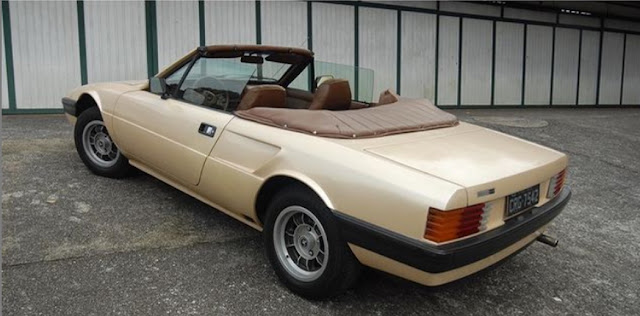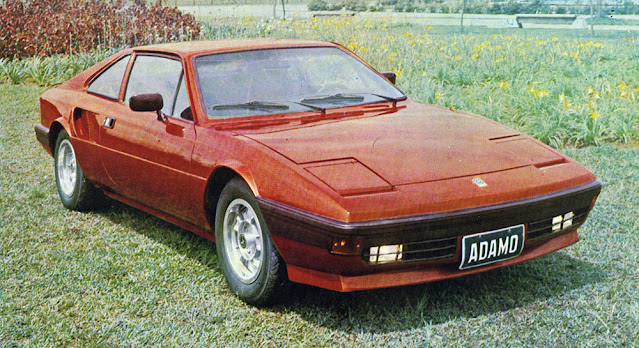The staying power of Adamo
As Brazilian independent boutique car manufacturers go, Adamo was among the ones that had a longer and more productive life than most. The company was created by Milton Adamo as an offshoot of the polyester furniture industry that the family had owned in São Paulo (SP) for a many years. It was his idea to diversify production towards sports cars, a natural path at a time when the newly created Puma began its rapid ascent, pushed by its beautiful GT which already become an object of desire of Brazilian motorists.
Adamo's first car was presented at the 6th São Paulo Motor Show in November 1968 at the Petrobras stand, in the form of a prototype. It was a small sports car with curvaceous lines and two seats, based on Volkswagen 1300 mechanicals. Although the initial plans were to begin sales at the beginning of the following year, Adamo chose to take time to perfect it, reintroducing it at the 7 São Paulo Motor Show, two years later as the Gt, with more aerodynamic lines and concealed headlights. Designed to carry four people, the car displayed its definitive lines, which would remain little changed for a few years.
The GT was put into different production from that shown in the motor show in two main aspects: it became an open car Targa style, without doors, and lost the luxurious finish, almost turning into a buggy. Maintaining the original length of the Volkswagen platforms he used in his cars, without shortening them, Adamo not only simplified the manufacture and provided a vehicle less subject to alignment and assembly defects, but also offered passengers the internal space of a real automobile.
With this, he practically created a new segment in the Brazilian market – a convertible that was half-sportscar, half-buggy. With fluid and elegant lines, the GT could receive a vinyl soft-top, which covered the Targa; the truncated rear was painted black and had four round taillights. Also daring were his protruding headlights mounted directly on the fenders, a simple and inexpensive solution generally found on traditional dune buggies and aesthetically less ambitious cars. The first Adamo was manufactured in series; it sold assembled, or in the form of kit. About 170 units were produced by 1975.
At the 9th National Motor Show in 1974, Adamo launched his first "real" GT, powered by VW's new 1500 engine. As in the previous model, an uncut VW platform was used here. Baptized the GT II, it was presented in two versions, "Gran Turismo" and "Targa", both with two seats, four round headlights built into the front and four taillights on the truncated rear (the display model featured Ford Mustang units). Seen from behind, the car resembled the Ferrari Dino, a look enhanced by the small slope of the narrow rear glass, which did not follow the body line.
Its performance, however, was unremarkable and only slightly better than that of the Beetle 1500, from which it derived. From mid-1975 it began to use the VW 1600 engine with two carburetors, but still without substantial improvement in results.
Its performance, however, was unremarkable and only slightly better than that of the Beetle 1500, from which it derived. From mid-1975 it began to use the VW 1600 engine with two carburetors, but still without substantial improvement in results.
1978, saw the debut of another creation of Adamo, the "GTL", mounted on the platform of the VW Brasilia. It featured rectangular concealable headlights and a style that again resembled the Ferrari (this time, the front of the 308 GT). In the rear, it used the taillight assembly of the Alfa Romeo 2600 and the narrow rear glass, mounted almost vertically, accentuated the width of the car and reinforced the sporty look.
 |
| The Adamo GTL |
Special attention was paid to the design of the cabin, which featured a complete and well-designed instrument panel and leather seats of in a high quality finish. Attention was also paid to safety, the car used laminated glass and three-point retractable seatbelts. The low center of gravity and the correct choice of rear tires contributed to good stability. The performance, however, remained mediocre, because, despite the use of dual carburetors, the air-cooled Volkswagen engine had already reached the limit of its development.
The late 70's were a particularly successful time for the company, having been marketed roughly 700 vehicles in two years, some of them exported to the U.S. as well as South Africa. In 1980 the GTL was updated, and its name was changed to GTM. The air intake for engine cooling migrated from the rear pillars to the body sides; the trunk was redesigned and had increased useable space, the taillights were replaced by those of Brasilia and the bumpers became more integrated and covered with rubber.
In the early 1980's Brazil was engulfed by a strong economic downturn and the crisis was particularly harsh for the auto industry, which recorded huge sales losses. The small manufacturers suffered the most, reaching 80% retraction. Even the Motor Show, until then a biennial event, was canceled for 1980, only restarting the following year.
Those who did not depend solely on the manufacture of cars managed to maintain a relatively regular pace of production. In Adamo's case, that was between eight and ten units per month, ensuring a certain level of comfort during the situation. Enough, in fact, that the company felt compelled to make a leap forward in the quality of its products. This resulted in Adamo designing its first model with a truly modern drivetrain, coming from the VW Gol GT, called the CRX 1.8.
Presented at the 13th Motor Show (with the name "Buzios"), it had a water-cooled in-line 1.8 engine, front-wheel drive, McPherson front suspension, and rear suspension consisting of longitudinal arms and helical springs. If from a mechanical point of view the CRX represented a radical break with the past, stylistically the change was less so. The new body design still recalled the previous model, especially at the front.
 |
| The Adamo CRX Targa |
The CRX was available in two versions: closed or with partially removable roof, producing a beautiful Targa. The GTM and C2 models on the Brasilia platform remained in production alongside the new car.
The second half of the 1980's brought more difficulties for small manufacturers. The "Crusader Plan", price freeze, stagnant domestic market, lack of a commercial structure to export, and weak unity of purposes between companies all contributed to the closure of many small industries in the period.
Adamo, however, resisted. He promoted some aesthetic changes in his models (side bands, elimination of the fake front grilles, narrower bumpers in GTM and C2), even participating in the 15th Motor Show in 1988, where he presented an elegant renovated C2 – the 2000 AC –, with a VW Santana 2.0 liter engine, new cleaner taillights and a cleaner body style, with no air inlets or rubber bumpers. At the same time Adamo sought diversification, also launching a personalization kit of the Chevrolet Monza, composed of new grille, bumper, hood, front fenders and rear spoiler - all molded in fiberglass - plus new fog lights at the show.
 |
| The Adamo AC2000 |
Adamo's various models continued to be produced in small quantities, on demand, until 1990, when the Brazilian small-series segment suffered its death blow, in the figure of Fernando Collor de Mello and his policy of deregulating the economy and radical opening of the market to imports.
The new competition of foreign cars ended an entire Brazilian industrial segment in a matter of months. Dozens of small manufacturers went bankrupt; very few survived and this time the crisis was fatal for Adamo as well.
Milton Adamo estimates that his company produced about 1,700 cars in the 20 years he worked in the sports car market. A testament to the drive and persistence of the man and his Marque.
 |
| Promo art of the Adamo GT in its final form |
 |
| The Adamo GT |
 |
| The Adamo GT2 at rear |
 |
| The Adamo GT2 Targa |
 |
| The Adamo GTM |
 |
| The Adamo GTM Cabrio, at rear |
 |
| The Adamo GTM Cabrio, with headlights exposed |
 |
| The Adamo GTM Cabrio |
 |
| A later series example of the Adamo GTM Coupe |
 |
| An early Adamo GT prototype, with an alternate headlight treatment |
 |
| The Adamo GT2 makes its debut in Sao Paolo in 1979 |








Hi, I have an Adamo GT I am planning on restoring it. It is mostly complete but is missing the windshield does anyone know if Adamo used a windshield from another car and if so what car did it come from the seats were badly deterated but looked like be seats
ReplyDelete